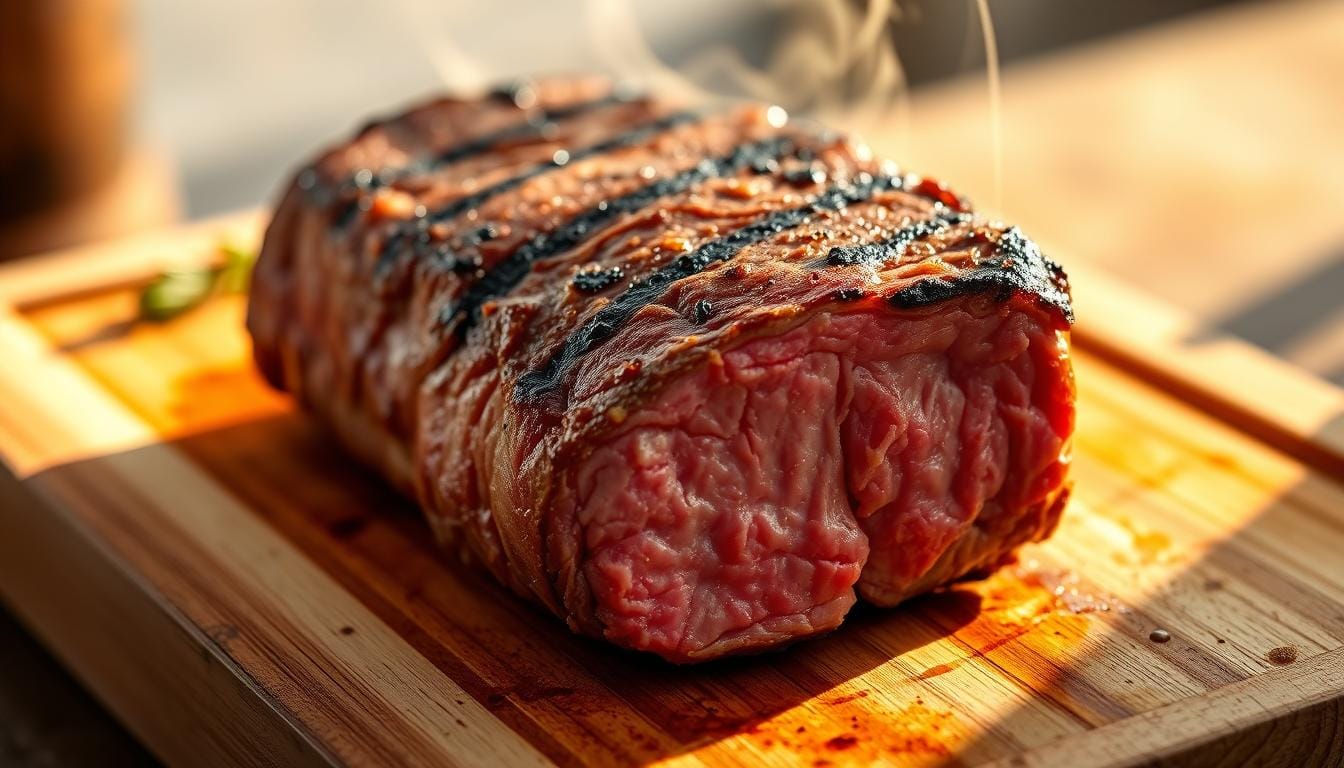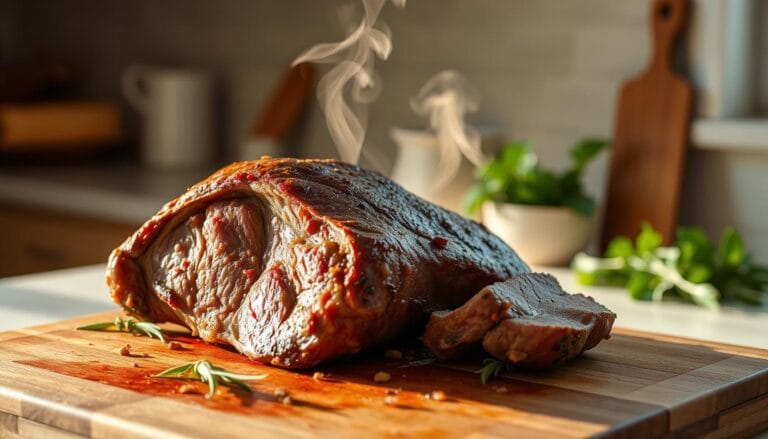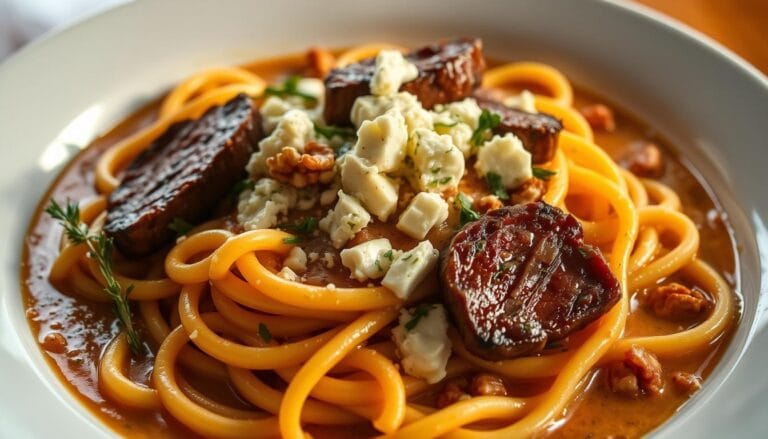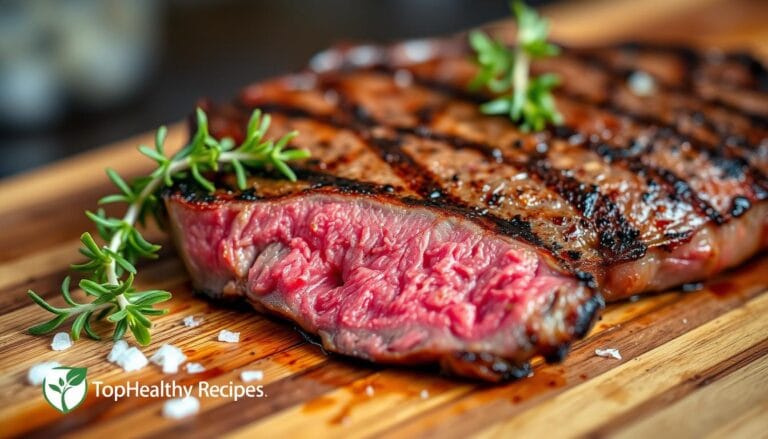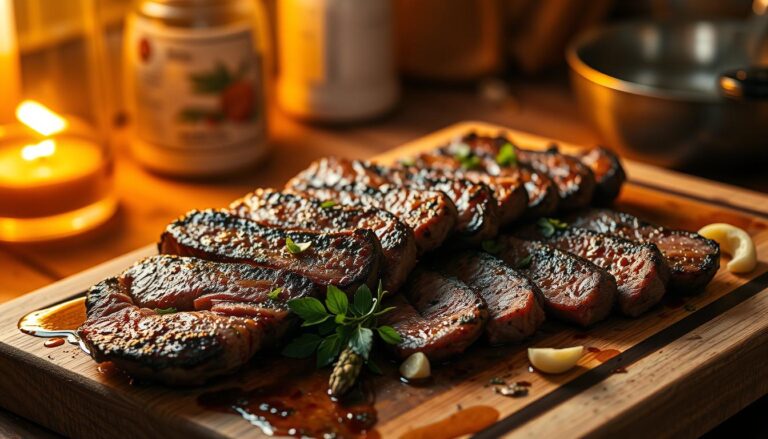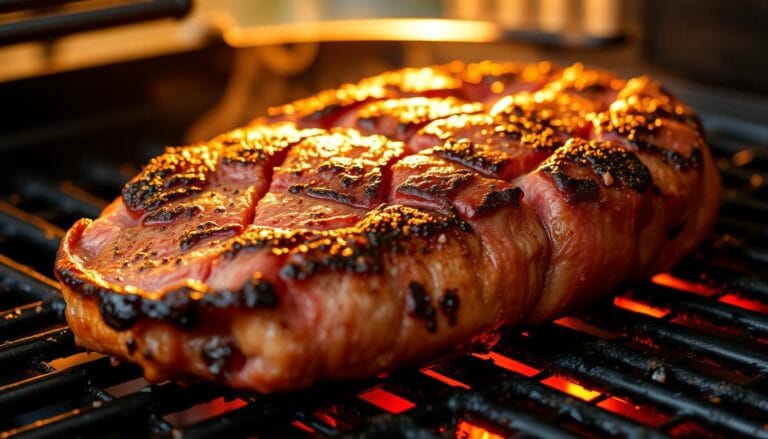Protein in 8 oz Sirloin Steak: Muscle Fuel with Amazing Flavor
Table of Contents
Protein in 8 oz Sirloin Steak: Muscle Fuel with Amazing Flavor
There’s something special about cutting into a perfectly cooked sirloin. The smell of savory meat fills the air. That first juicy bite feels like a reward for your hard work.
Whether you’re fueling up after a workout or hosting a barbecue, this cut is more than satisfying. It’s a powerhouse of nutrition with bold, delicious taste.
Imagine a meal that supports your fitness goals without losing flavor. Sirloin steak does just that. It’s lean yet tender, packed with high-quality nutrients your body needs.
For active people, every ounce matters. An 8-ounce portion gives you a big dose of muscle-building essentials. It’s a smart choice for anyone looking to build strength or recover.
But sirloin steak is also a culinary delight. A well-seasoned sirloin, seared to perfection, turns dinner into an experience. It’s perfect for quick meals or special occasions, showing that health-conscious eating doesn’t mean boring food. Here’s why this steak is a kitchen staple and a nutritional ally.
Key Takeaways
- A single 8-ounce serving provides over half the daily protein needs for most adults
- Rich in essential amino acids for efficient muscle repair and growth
- Balances lean texture with rich, beefy flavor for guilt-free indulgence
- Contains vital nutrients like iron and B vitamins beyond just protein
- Versatile cooking methods adapt to both fitness routines and gourmet cravings
Understanding Protein and Its Importance
Protein is more than just a trend—it’s essential for our bodies. It helps build muscle, repair tissues, and balance hormones. An 8 oz sirloin steak is a top choice for getting a lot of protein.
What Is Protein?
Protein is made of amino acids, which are vital for life. Our bodies need 20 different amino acids, nine of which are essential. These essential amino acids come from animal sources like sirloin steak, making them complete proteins. Plant-based foods often lack some amino acids, so you need to mix them to get all nine.
Why You Need Protein
Protein is key for every cell in your body. It does many important things:
- Repairs muscles after workouts
- Boosts immunity through antibody production
- Keeps skin and hair healthy
Adults need about 0.36 grams of protein per pound of body weight each day. For someone who weighs 150 pounds, that’s 54 grams. An 8 oz sirloin steak has almost that much protein by itself.
Types of Protein Sources
Not all proteins are the same. Here’s a comparison:
| Source | Protein per 8 oz | Complete Amino Acids? |
|---|---|---|
| Sirloin Steak | 54g | Yes |
| Chicken Breast | 52g | Yes |
| Black Beans | 30g | No |
While plant-based proteins are good for some, sirloin is unmatched. It gives you all essential amino acids in one serving. This is great for people who are always on the go.
Nutritional Breakdown of Sirloin Steak
Knowing what you eat is key, and sirloin steak is a top choice. It’s packed with nutrients. Let’s explore the details so you can choose better meals.
Calories in 8 oz Sirloin Steak
An 8 oz sirloin steak has about 330 calories, says the USDA. It has more iron and zinc than chicken breast. This makes it great for those who are active or building muscle.
Macronutrient Profile
Here’s what you get in every 8 oz portion:
- 54g protein – enough to meet most daily needs in one meal
- 12g fat (only 5g saturated)
- 0g carbs
Sirloin is perfect for low-carb diets. You’d need 3 cups of cooked lentils to get 54g of protein, plus 120g of carbs.
Vitamins and Minerals
Sirloin is rich in vitamins and minerals. A single serving gives you:
- 20% of your daily iron (supports oxygen transport)
- 50% of your zinc (boosts immunity)
- 150% of vitamin B12 (fuels nerve function)
Compared to chicken breast, sirloin has 3x more iron and double the zinc. Even salmon can’t match the B12 in steak, which is good for your brain.
| Nutrient | Sirloin (8 oz) | Chicken Breast (8 oz) | Lentils (3 cups) |
|---|---|---|---|
| Protein | 54g | 52g | 18g |
| Iron | 3.6mg | 1.3mg | 6.6mg |
| Zinc | 7mg | 1.9mg | 2.5mg |
The Protein Content in an 8 oz Sirloin Steak
Planning meals for muscle growth or recovery means knowing your protein intake. An 8 oz sirloin steak packs a lot of this key nutrient. Let’s look at the numbers, compare it to other cuts, and see why its quality is top-notch.
How Much Protein Is There?
A cooked 8 oz sirloin steak has 54–63 grams of protein. This depends on fat content and how it’s cooked. Leaner cuts have more protein, while fattier ones have less. This amount meets over 100% of the daily protein needs for most adults in just one meal.
Comparison with Other Steaks
Let’s see how sirloin compares to other popular steaks:
| Steak Cut (8 oz) | Protein (g) | Fat (g) |
|---|---|---|
| Sirloin | 54–63 | 10–15 |
| Ribeye | 48–55 | 20–30 |
| Filet Mignon | 50–58 | 12–18 |
Sirloin has more protein per ounce than ribeye or filet mignon. It also has less fat, making it great for lean gains without too many calories.
Protein Quality in Sirloin Steak
Sirloin has a 0.92 on the PDCAAS scale, close to eggs and milk. It has all nine essential amino acids, including leucine, which helps build muscle. Your body can absorb up to 95% of its protein, much more than plant-based sources.
Grass-fed sirloin might have even better nutrients, like more omega-3s and antioxidants. But grain-fed sirloin is also very high in protein quality for recovery after workouts.
The Role of Protein in Muscle Building
An 8 oz sirloin steak is more than just a meal. It’s a powerful tool for those who want to build muscle. The high-quality protein in this cut helps your body repair and grow. It works best when you eat it at the right time.
How Protein Affects Muscle Growth
Protein from sirloin steak has all nine essential amino acids. Leucine is one of them, and it starts muscle growth. Eating 20–40 grams of protein within 2 hours of working out is key.
- Leucine starts the rebuilding process in your muscles.
- Complete proteins like beef help your muscles recover during hard workouts.
“Muscle growth needs both the right amount and quality of protein. Sirloin’s amino acids make it great for athletes.”
Post-Workout Recovery
Eating an 8 oz sirloin steak after working out has three main benefits:
- Rapid repair: Its fast-digesting proteins help reduce soreness.
- Iron replenishment: It helps your muscles get the oxygen they need to recover.
- Creatine content: It boosts your strength for the next workout.
Adding carbs like sweet potatoes helps by raising insulin levels. This moves nutrients into your muscles.
Daily Protein Needs for Athletes
People who are active need 1.2–2.2 grams of protein per kilogram of body weight every day. Here’s how an 8 oz sirloin fits into different routines:
| Activity Level | Daily Protein Goal (150 lb person) | % Provided by 8 oz Sirloin |
|---|---|---|
| Moderate Exercise | 82–109g | 48–64% |
| Strength Training | 109–150g | 35–48% |
Eat protein in 4–5 meals to keep building muscle all day.
Cooking Methods Impact on Nutritional Value
Choosing how to cook your 8 ounce steak matters more than you think. It affects the nutrients you get. High heat and cooking time can change the protein content. Certain cooking methods help keep vitamins and minerals in your steak.
Grilling vs. Pan-Searing
Grilling keeps 95% of the protein in an 8 ounce sirloin steak, USDA data shows. The open flame cooks meat fast and lets fat drip away, saving nutrients. Pan-searing, though tasty, keeps about 89% of protein because it cooks longer.
To keep more nutrients:
- Use a drip tray when grilling to catch juices
- Limit oil when pan-searing to avoid excessive fat absorption
- Cook to medium-rare (130-135°F) for optimal protein preservation
Baking and Broiling
Oven-based methods like baking and broiling cook meat evenly. Baking at 375°F keeps 93% of protein intact by cooking slowly in its juices. Broiling cooks fast but might lose more nutrients if overcooked.
For best results:
- Use a meat thermometer to prevent drying
- Line baking sheets with foil to collect nutrient-rich drippings
- Rest steaks 5 minutes before cutting to retain moisture
Sous Vide Cooking
Sous vide (water bath cooking) is precise, keeping 97% of protein in your 8 ounce steak. Vacuum-sealing and cooking at exact temperatures (usually 129-135°F) ensures no nutrient loss. This method:
- Prevents nutrient loss from evaporation or dripping fat
- Maintains B vitamins better than high-heat methods
- Requires no added oils, keeping calories in check
Your cooking choice affects not just taste but also protein content. Quick-cooking methods with controlled heat usually win over long, hot cooking. Always let your steak rest after cooking. Those juices are full of valuable nutrients you don’t want to lose!
Tips for Choosing the Best Sirloin Steak
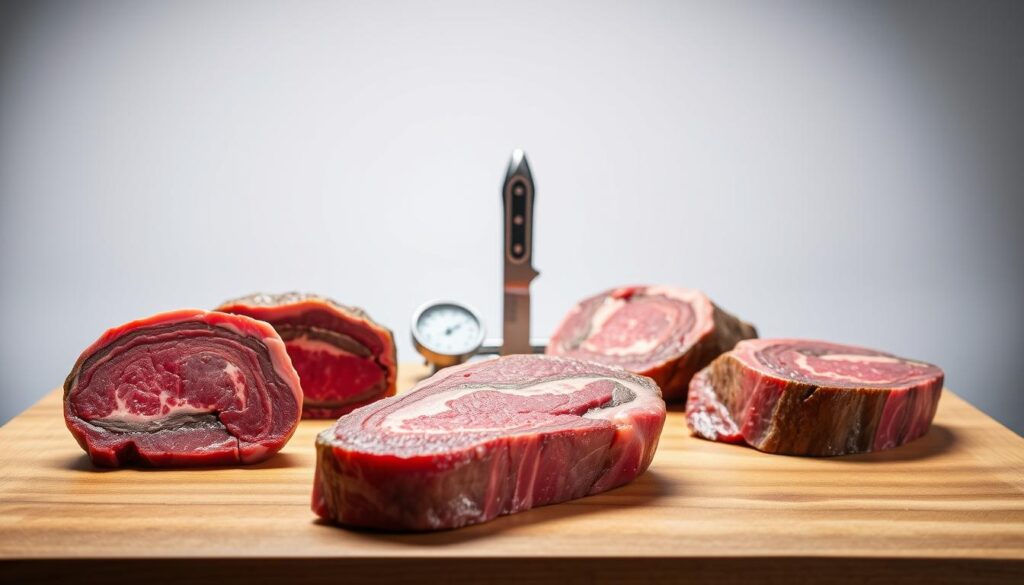
Choosing the right 8 oz sirloin steak is more than just picking the first one you see. Quality, taste, and health depend on three things: marbling, portion size, and where you buy it. Let’s explore how to make choices that boost both flavor and protein.
Look for Marbling
Marbling—the thin white streaks of fat in the meat—is key for flavor. More marbling means a richer taste and juicier texture. USDA Choice and Prime grades have the most marbling, making them tender and flavorful.
Steer clear of very lean cuts, as they can become tough when cooked. Opt for moderate marbling, like delicate snowflakes in the meat. This keeps your 8 oz sirloin steak moist and packed with over 50 grams of protein.
Size and Cut Options
An 8 oz portion is perfect for one serving, but thickness is also important. Choose steaks 1–1.5 inches thick to keep juices in during cooking. For leaner options, ask for top sirloin, which has less fat than center cuts.
Feeling lost with labels? Here’s a quick guide:
- “Boneless”: Easier to slice and cook evenly
- “Aged”: Enhanced tenderness and deeper flavor
- “Grass-fed”: Leaner with higher omega-3 content
Where to Buy Quality Steak
Avoid the supermarket’s pre-packaged section. Instead, go for local butcher shops or specialty online stores. They offer fresher 8 oz sirloin steaks with clear origins. Butchers can also:
- Custom-cut steaks to your preferred thickness
- Explain the meat’s origin (look for U.S.-raised cattle)
- Recommend cooking methods based on marbling levels
For top-notch quality, look at brands like Snake River Farms or Allen Brothers. They ship vacuum-sealed steaks across the country. Always check for USDA grading on the label—it ensures marbling and tenderness.
Incorporating Sirloin Steak into Your Diet
Planning meals with 8 oz sirloin protein means every bite is tasty and healthy. It’s great for workouts or a balanced diet. Here are some easy ways to add it to your meals.
Meal Ideas with Sirloin Steak
Here are three simple meal ideas:
- High-Protein Power-Up: Top scrambled eggs and spinach with 8 oz sirloin. Add a Greek yogurt parfait for over 45g protein.
- Keto-Friendly Feast: Enjoy steak with avocado mash and roasted Brussels sprouts. It’s low in carbs and high in healthy fats.
- Balanced Weeknight Dinner: Grill sirloin, serve with quinoa and steamed broccoli. It’s packed with 30g protein and fiber for energy.
Balancing Your Plate
Follow this simple rule for every meal:
- Fill half your plate with veggies like asparagus or bell peppers.
- Use 25% for your 8 oz sirloin.
- Fill the rest with complex carbs like wild rice or sweet potatoes.
This method helps control portions and boosts nutrient variety.
Pairing with Vegetables and Grains
Boost iron from steak by adding:
- Vitamin C-rich veggies: Bell peppers or tomatoes increase iron absorption by 50%.
- Whole grains: Quinoa helps with protein synthesis.
- Leafy greens: Spinach supports muscle function with magnesium.
“Pairing lean beef with colorful plants creates meals that satisfy both taste buds and nutritional needs.”
Health Benefits of Eating Sirloin Steak
Eating an 8 oz sirloin steak is more than just a tasty meal. It’s a smart choice for your health. It boosts your energy and helps protect your immune system. This lean cut offers many benefits beyond basic nutrition.
High Iron Content
Sirloin steak is full of heme iron. Your body absorbs this iron 15-35% better than plant-based sources. This is great for preventing fatigue and anemia. Athletes, pregnant people, and those with iron deficiencies get the most benefits from this protein.
| Iron Type | Absorption Rate | Top Sources |
|---|---|---|
| Heme Iron | 15-35% | Sirloin steak, chicken liver, oysters |
| Non-Heme Iron | 2-20% | Spinach, lentils, tofu |
Supporting Immune Function
An 8 oz sirloin steak gives you almost half your daily zinc. Zinc is key for making white blood cells, your body’s defense against infections. With selenium and vitamin B6, sirloin steak is a strong ally for your immune system.
- Zinc: Activates T-cells to target pathogens
- Selenium: Reduces oxidative stress
- Vitamin B6: Regulates inflammation
Benefits for Brain Health
Vitamin B12 in sirloin steak helps your nerves and brain work better. One serving gives you over 100% of your daily B12. This helps prevent brain fog and memory loss. Studies also show it may lower the risk of dementia.
Grass-fed sirloin steak also has omega-3 fatty acids. These fats protect your brain, improving focus and mood. Eating your steak with leafy greens boosts these benefits even more.
Addressing Common Myths About Red Meat
Red meat often gets a bad rap in nutrition talks. But, knowing the truth can let you enjoy your 8-ounce steak without feeling guilty. Let’s debunk three common myths with science.
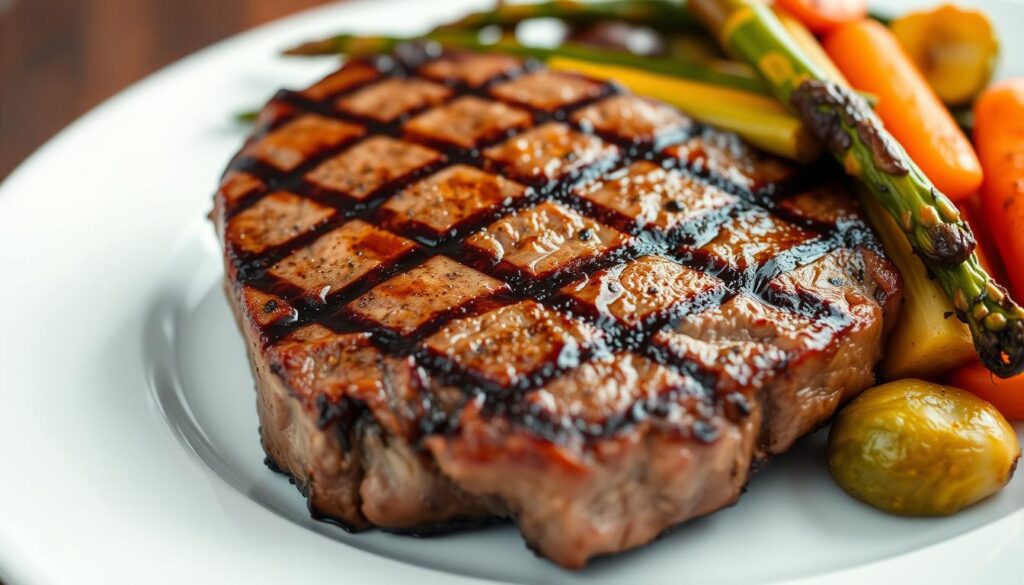
Red Meat and Heart Health
Lean cuts like sirloin steak don’t necessarily harm your heart. A 2023 study in the American Journal of Clinical Nutrition showed that eating moderate amounts of unprocessed red meat doesn’t raise cholesterol for most adults. Just remember to trim fat and eat 3-4oz portions, not big 8oz servings every day.
Environmental Concerns
Beef production does use resources, but the whole story is more complex. Ranchers have cut water use by 10% per pound of beef. This is less than what almond production uses – 1,929 gallons per pound.
“Grass-fed systems can sequester carbon in soil, offsetting part of livestock emissions.” – Journal of Animal Science (2022)
Moderation vs. Elimination
You don’t have to give up steak to be healthy. Experts suggest:
- Enjoying 3-4oz portions 3x weekly
- Pairing with antioxidant-rich vegetables
- Choosing grass-fed options when possible
This way, you get the good stuff from high-quality protein without too much saturated fat. Your 8-ounce steak can be split into two meals, like on salads or in stir-fries.
Understanding Serving Sizes
Knowing how much to eat is as important as choosing the right foods. An 8 oz sirloin steak is packed with protein. But, it’s key to balance portion sizes to meet your goals without too many calories. Let’s explore what a healthy serving looks like and how to fit it into your lifestyle.
What Counts as a Portion?
A standard serving of cooked sirloin steak is 3–4 ounces, about the size of a deck of cards. But an 8 oz cut is double that, with 54 grams of protein. That’s almost 98% of what sedentary adults need in a day. Active people might need more, but this portion covers a big part of daily needs in one meal.
Visual Portion Control
Having trouble judging sizes? Try comparing your steak to everyday objects:
- An 8 oz portion is slightly larger than a smartphone.
- Thickness should match the width of two stacked credit cards.
- Raw weight shrinks by 25% during cooking.
How It Fits Into Your Daily Diet
Pair your steak with fiber-rich veggies and whole grains for balance. If you’re active, spread out your protein intake. An 8 oz sirloin steak provides enough protein for most people at lunch or dinner. This leaves room for eggs, Greek yogurt, or plant-based sources later.
“Aim for 0.36 grams of protein per pound of body weight daily. Athletes may need up to double that.”
Protein Timing for Optimal Results
Eating protein at the right times is key for muscle building and recovery. An 8 oz sirloin steak is packed with high-quality protein. But, when you eat it is just as important as how much. Let’s explore how to time your steak for the best results.
Best Times to Consume Protein
Your body absorbs protein best when it’s spread out over meals. Aim for 20–40 grams of protein every 3–4 hours. This keeps your muscles working. An 8 oz sirloin steak has about 50 grams, perfect for after workouts or dinner.
Pre- and Post-Workout Protein Needs
After working out, your muscles are ready to take in nutrients. Studies show eating 20–40 grams of protein within 2 hours helps recovery the most. A grilled sirloin steak is great for this, providing quick protein and iron for energy.
| Timing | Protein Goal | Steak Preparation Tip |
|---|---|---|
| Pre-Workout (1–2 hours prior) | 15–20g | Opt for lean cuts to avoid digestive discomfort |
| Post-Workout (within 2 hours) | 20–40g | Pair with veggies for faster nutrient absorption |
Spreading Protein Intake Throughout the Day
Instead of eating all your protein at once, spread it out. Here’s how an 8 oz sirloin fits into your daily plan:
- Breakfast: Eggs or Greek yogurt (20g protein)
- Lunch: Chicken or fish (25–30g protein)
- Dinner: 8 oz sirloin steak (50g protein)
This way, you keep your muscles repairing all day. If you have a small appetite, try splitting the steak into two 4 oz servings.
Dietary Considerations for Sirloin Steak
The 8 oz sirloin steak is great for many diets. It’s easy to adjust without losing taste or nutrients. Let’s see how it fits into various eating plans.
Low-Carb and Keto Diets
The 8 oz sirloin steak is perfect for low-carb diets. It has zero grams of carbohydrates and lots of good fats. Here’s why it’s good for keto:
- It has 55-60g protein to keep muscles strong while losing fat
- It has natural fats that help with ketosis when eaten with avocado or olive oil
- It’s great in bulletproof coffee for those fasting
Paleo Approach
Sirloin fits well with paleo eating. For the best results:
- Go for grass-fed cuts for more omega-3s
- Eat it with roasted root veggies instead of grains
- Use natural seasonings like garlic powder and smoked paprika
Preparing for Special Diets
Adjust your 8 oz sirloin steak for special diets with these tips:
| Diet Type | Modification | Flavor Boosters |
|---|---|---|
| Low-Sodium | Replace salt with lemon zest | Rosemary, thyme, black pepper |
| Gluten-Free | Use tamari instead of soy sauce | Fresh ginger, sesame oil |
| Dairy-Free | Swap butter with ghee | Chimichurri sauce, roasted garlic |
For heart health, trim fat before cooking. Use herb-based marinades instead of store-bought sauces. Always talk to a nutritionist before big diet changes.
Avoiding Overcooking Your Steak
To get the perfect doneness in an 8 oz sirloin, you need to be precise and patient. Overcooking makes the meat dry and loses its protein quality. We’ll look at how to keep it juicy, flavorful, and nutritious.
Ideal Cooking Temperatures
For a medium-rare 8 ounce steak, aim for an internal temperature of 130°F. This makes it tender and keeps the center pink and tasty. Remember, the temperature will rise by 5°F after you take it off the heat. So, adjust your timing to avoid overcooking.
| Doneness Level | Target Temp (°F) | Final Temp After Resting |
|---|---|---|
| Rare | 120-125 | 125-130 |
| Medium-Rare | 130-135 | 135-140 |
| Medium | 140-145 | 145-150 |
Using a Meat Thermometer
Put the probe into the thickest part of your 8 ounce steak for accurate readings. Digital thermometers give you instant feedback. They help you remove the meat at the perfect time. Don’t guess – this tool is your best defense against dry, overcooked beef.
Resting Time for Juicy Steak
Let your steak rest for 5-10 minutes before slicing. This lets juices spread evenly through the meat. Cutting too soon can lose up to 40% of the flavorful juices. This leaves your steak dry and less satisfying.
Exploring Flavor Enhancements
Getting the most out of your 8 oz sirloin steak is more than just cooking. It’s about layering flavors to make it richer and healthier. Whether you prefer a zesty marinade or a savory rub, small changes can make your steak taste like a gourmet dish. And it won’t hurt your health goals.
Marinades and Rubs
Healthy marinades make your steak taste better without adding too many calories. Try a citrus-herb blend with olive oil, lemon juice, garlic, and rosemary. Or, for a smoky flavor, use a coffee-chili rub (coffee, smoked paprika, and cumin).
Marinate for at least 2 hours. Acidic bases like citrus tenderize the meat. Coffee rubs help keep it moist.
Seasoning Tips for Steak
Timing is everything for a great crust. Salt your steak 40 minutes before cooking to remove excess moisture. This moisture then reabsorbs, making seasoning even.
Use coarse salt, black pepper, garlic powder, and smoked paprika. Let the steak sit at room temperature for 20 minutes after seasoning. This helps flavors penetrate deeper.
Sides That Complement Sirloin
Choose sides that balance your steak’s richness. Roasted garlic cauliflower mash is a creamy, low-carb option instead of potatoes. Just blend steamed cauliflower with roasted garlic and almond milk.
For extra texture, try:
- Grilled asparagus with lemon zest
- Quinoa salad with cherry tomatoes and basil
- Sautéed spinach with garlic and olive oil
These sides add fiber and vitamins, making your meal a nutrient-dense powerhouse.
Summarizing the Benefits of Sirloin Steak
An 8 oz sirloin steak is more than just tasty—it’s packed with nutrients. It has high-quality protein, vitamins, and minerals. These help grow muscles, boost energy, and improve overall health. It’s a great choice for anyone looking to fuel their active lifestyle.
Recap of Nutritional Advantages
This lean cut has about 56 grams of protein in an 8 oz serving. It’s a good source of iron, zinc, and B vitamins like B12. Unlike processed meats, sirloin is low in sodium and preservatives.
Quick Reference Protein Facts
One serving of sirloin steak gives you almost 70% of the daily protein for a 150-pound adult. Its amino acids are as good as chicken breast and salmon. It’s perfect for muscle recovery after working out. Pair it with veggies or quinoa for a balanced meal.
Making Sirloin Steak Part of a Balanced Diet
Make sirloin a regular part of your diet by grilling it for salads, stir-fries, or tacos. Choose grass-fed options from ButcherBox or Omaha Steaks for more omega-3s. Eat 3-4 oz at a time if watching calories, and use a meat thermometer to cook it right.
Here’s a weekly meal plan: Grill 8 oz sirloin on Monday (split into two meals), use leftovers in Wednesday’s grain bowl, and pan-sear a fresh cut for Friday’s dinner. Serve it with greens, sweet potatoes, or brown rice for meals that fit keto, paleo, or high-protein diets.
FAQ
How much protein is in an 8 oz sirloin steak?
Is sirloin steak better for protein than chicken or plant-based options?
Does grilling reduce the protein content of sirloin steak?
Can sirloin steak fit into a keto or low-carb diet?
What vitamins and minerals does sirloin provide beside protein?
How does marbling affect protein quality in sirloin?
Is sirloin steak effective for post-workout recovery?
How often should I eat sirloin steak for maximum benefits?
What’s the healthiest way to cook sirloin to preserve nutrients?
Can sirloin steak help prevent iron deficiency?
For more cooking tips, stay connected with us. We also recommend the cookbook Skinnytaste Simple: Easy, Healthy Recipes with 7 Ingredients or Fewer
For more Recipes about Steak ?
Did You try our recipe ?
There are no reviews yet. Be the first one to write one.
